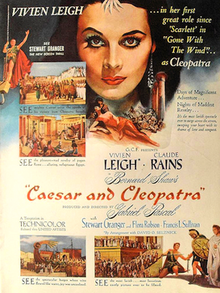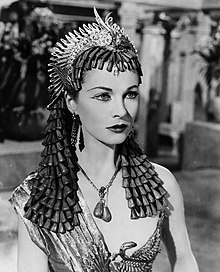Caesar and Cleopatra (film)
| Caesar and Cleopatra | |
|---|---|
 theatrical release poster | |
| Directed by | Gabriel Pascal |
| Written by | George Bernard Shaw (play {uncredited}, scenario and dialogue) |
| Produced by | Gabriel Pascal |
| Starring | Vivien Leigh Claude Rains |
| Cinematography | F. A. Young F.R.P.S. Robert Krasker Jack Hildyard Jack Cardiff |
| Edited by | Frederick Wilson Joan Warwick (uncredited) |
| Music by | Georges Auric |
Production company | |
| Distributed by | Eagle-Lion Films (UK) United Artists (US) |
Release dates | 11 December 1945 (London) 6 September 1946 (US) 16 September 1946 (UK) |
Running time | 128 minutes (UK) 123 minutes (US) |
| Country | United Kingdom |
| Language | English |
| Budget | US$5.2 million[1] or £1.3 million[2][3] |
| Box office | US$2,250,000 (US rentals)[4] 815,007 admissions (France)[5] £350,000 (US$1.4 million) (UK)[3] |
Caesar and Cleopatra is a 1945 British Technicolor film directed by Gabriel Pascal and starring Vivien Leigh and Claude Rains.[6] Some scenes were directed by Brian Desmond Hurst, who took no formal credit. The picture was adapted from the play Caesar and Cleopatra (1901) by George Bernard Shaw, produced by Independent Producers and Pascal Film Productions and distributed by Eagle-Lion Distributors.
Upon release, Caesar and Cleopatra failed to earn back its colossal budget. John Bryan was nominated for an Oscar for Best Art Direction.[7]
Plot
Aging Julius Caesar takes possession of the Egyptian capital city of Alexandria and tries to resolve a feud between the young princess Cleopatra and her younger brother Ptolemy. Caesar develops a special relationship with Cleopatra and teaches her how to use her royal power.
Cast

- Vivien Leigh as Cleopatra
- Claude Rains as Caesar
- Stewart Granger as Apollodorus
- Flora Robson as Ftatateeta
- Francis L. Sullivan as Pothinus
- Basil Sydney as Rufio
- Cecil Parker as Britannus
- Raymond Lovell as Lucius Septimus
- Anthony Eustrel as Achillas
- Ernest Thesiger as Theodotus
- Anthony Harvey as Ptolemy
- Robert Adams as Nubian Slave
- Olga Edwardes
- Harda Swanhilde as Cleopatra's Lady Attendants
- Michael Rennie as 1st Centurion
- James McKechnie as 2nd Centurion
- Esme Percy as Major Domo
- Stanley Holloway as Belzanor
- Leo Genn as Bel Affris
- Alan Wheatley as Persian
- Anthony Holles as Boatman
- Charles Victor as 1st Porter
- Ronald Shiner as 2nd Porter
- John Bryning as Sentinel
- John Laurie as 1st Auxiliary Sentinel
- Charles Rolfe as 2nd Auxiliary Sentinel
- Felix Aylmer as 1st Nobleman
- Ivor Barnard as 2nd Nobleman
- Valentine Dyall as 1st Guardsman
- Charles Deane as 2nd Guardsman
Production
Filmed in Technicolor with lavish sets, the production was reported to be the most expensive film ever made at the time, costing £1,278,000 (or £60.2 million at 2023 value), or US$5.15 million (or US$69.1 million at inflation-adjusted value) at contemporary exchange rates.[8] Caesar and Cleopatra held that record until Duel in the Sun was produced in 1946.
Director Gabriel Pascal ordered sand from Egypt in order to achieve the proper cinematic colour. The production ran into delays because of wartime restrictions.[9] During the shoot, Vivien Leigh, who was pregnant, tripped and suffered a miscarriage. The incident triggered Leigh's manic depression, leading to her emotional breakdown, and halted production for five weeks.[1]
The film was described as a "box office stinker" at the time and almost ended Pascal's career. It was the first Shaw film made in colour, and the last film version of a Shaw play during his lifetime. After Shaw's death in 1950, Pascal produced Androcles and the Lion, another Shaw-derived film, in 1952.
Reception
Box office
According to trade papers, the film was a "notable box office attraction" at British cinemas.[10][11] According to Kinematograph Weekly, the top British box-office draw for 1946 was The Wicked Lady.[12]
The film earned $1,363,371 in the United States, making it one of the more popular British films ever released there.[13] However, the film's receipts fell short of initial expectations. Variety estimated that Rank lost $3 million (or $35.8 million at 2023 value) on the film after marketing, distribution, prints, insurance rights, and wages were taken into account.[3]
See also
References
Notes
- ^ a b Steinberg, Jay S. "Caesar and Cleopatra" (article) TCM.com
- ^ "The London Letter: Loan Vote Prospects" The Scotsman [Edinburgh, Scotland] 13 Dec 1945: 4.
- ^ a b c Staff (30 October 1946) "'Cleo' $3,000,000 in the red", Variety, p.3
- ^ Staff (8 January 1947) "60 Top Grossers of 1946" Variety p,8
- ^ Box office information for Stewart Granger films in France at Box Office Story
- ^ "Caesar and Cleopatra (1945)". Archived from the original on 16 January 2009. Retrieved 1 August 2018.
- ^ "946 (19th) Art Direction (Color) Caesar and Cleopatra John Bryan"[permanent dead link]
- ^ "Noteworthy Films Made In U.K." The West Australian. Perth: National Library of Australia. 17 January 1953. p. 27. Retrieved 4 August 2012.
- ^ "Caesar and Cleopatra" (1945) home video review, TCM.com
- ^ Murphy, Robert (2003) Realism and Tinsel: Cinema and Society in Britain 1939-48 p.209
- ^ Thumim, Janet. "The popular cash and culture in the postwar British cinema industry". Screen. Vol. 32, no. 3. p. 258.
- ^ Lant, Antonia (1991). Blackout : reinventing women for wartime British cinema. Princeton University Press. p. 232.
- ^ Street, Sarah (2002) Transatlantic Crossings: British Feature Films in the USA, Continuum, p.94
Bibliography
- Vermilye, Jerry. (1978) The Great British Films, Citadel Press, pp. 97–101. ISBN 0-8065-0661-X
External links
- Template:BFI
- Caesar and Cleopatra at IMDb
- Caesar and Cleopatra at Rotten Tomatoes
- Caesar and Cleopatra at the TCM Movie Database
- Caesar and Cleopatra at AllMovie
- Review of film at Variety
- Gabriel Pascal directs Shaw's Caesar and Cleopatra 1945 on YouTube (Newsreel)
- Film Facts
- Pascal with Jean Simmons at premiere 13 December 1945
- 1945 films
- 1945 romantic comedy films
- British epic films
- British romantic comedy films
- 1940s English-language films
- Depictions of Julius Caesar on film
- Depictions of Cleopatra on film
- Films based on works by George Bernard Shaw
- British films based on plays
- Films set in ancient Rome
- Films set in Egypt
- United Artists films
- Films directed by Gabriel Pascal
- Films produced by Gabriel Pascal
- Films scored by Georges Auric
- 1940s British films
